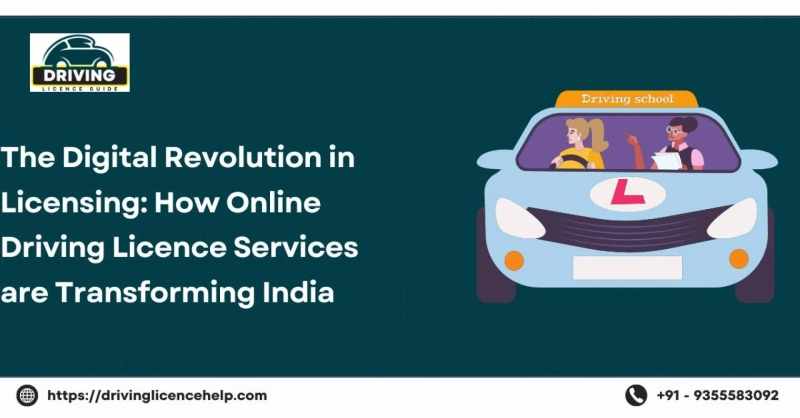In a fast-paced and digitally connected India, the process of getting a driving licence has undergone a significant transformation. From standing in long queues at Regional Transport Offices (RTOS) to now applying for licences with a few clicks, the evolution of the driving licence system marks a major leap towards transparency, efficiency, and citizen empowerment.
This article explores the unique topic of how digitalisation has changed the way Indians apply for and manage their driving licences—and why this transformation is more than just convenience.
The Traditional Licensing System: A Quick Look Back
Before the introduction of online services, applying for a driving licence in India was often seen as a complicated and tedious process. Applicants had to:
- Visit the RTO multiple times
- Fill out long physical forms
- Deal with brokers or middlemen
- Face delays and errors in paperwork
- Wait months for their licence delivery
These challenges discouraged many people, especially those in rural or remote areas, from acquiring a valid licence.
Key Features of the Online Driving Licence System
Online Application for Learner’s and Permanent Licence
Users can now fill out forms online for:
- Learner’s licence
- Permanent driving licence
- Renewal of expired licence
- Duplicate licence in case of loss/damage
- Addition of vehicle class (e.g., adding LMV to the existing licence)
No more repeated visits for form collection or submission.
Slot Booking for Driving Tests
Through the portal, applicants can choose test dates as per availability, reducing crowding and wait time at RTOS.
Online Fee Payment
Payments for learner tests, driving tests, and renewal are now cashless and secure, eliminating the need for handling currency at RTO counters.
Real-Time Application Tracking
Users can track the status of their application using application numbers or mobile OTPS, ensuring transparency in the approval process.
Digital Document Upload
Applicants can upload ID proof, age proof, and address proof online. Aadhaar integration further simplifies the process.
Benefits of the Digital Licensing System
Time-Saving
Online services significantly reduce the time taken from application to issuance of the licence. What once took weeks can now be done in a matter of days.
Increased Transparency
Every step of the application is trackable. Applicants receive SMS/email updates at each stage.
Improved Record-Keeping
All licence records are now stored digitally, helping RTOS, traffic police, and insurance companies access valid information instantly.
Paperless and Environment-Friendly
E-licences stored in DigiLocker reduce the need for physical documents. Less paperwork means less wastage.
How It Benefits Different Segments of Society
Rural Citizens
Thanks to Common Service Centres (CSCS) in villages, people living in rural areas can now apply for licences without travelling to cities.
Youth and Students
Digital applications are a boon for college students and first-time drivers. They can schedule tests during college breaks and upload documents online.
Working Professionals
Office-goers can avoid taking multiple days off just to visit the RTO. They can manage the entire process online at their convenience.
Elderly Applicants
Senior citizens applying for licence renewal benefit greatly from doorstep document upload and digital verification, reducing the need for physical exertion.
Innovations and What’s Coming Next
AI-Based Driving Tests
Some cities are piloting AI-enabled driving test tracks that assess applicants’ skills using sensors and cameras instead of human examiners.
E-Learning for Learner’s Licence
Instead of reading booklets, applicants can now watch animated tutorials and take mock tests online before appearing for the learner's test.
QR Code-Based Licences
New smart card driving licences come with QR codes, allowing traffic cops to instantly verify the licence holder’s details.
Facial Recognition in Driving Tests
To avoid impersonation or fraud, facial recognition technology is being tested to match the person giving the test with their documents.
Role of Schools and NGOS in Promoting Digital Driving Licence Awareness
Schools and NGOS can contribute by:
- Organising workshops on how to apply for a driving licence
- Teaching students and parents about online platforms like Parivahan
- Creating tutorial videos or guides in regional languages
- Helping people with limited internet access apply through CSCS
These steps ensure that the benefits of digital licensing reach every section of society.
Driving Licence as a Universal Identity Tool
A driving licence is not just for driving—it is widely accepted as an identity and address proof. Its role has expanded into areas like:
- Hotel check-ins
- SIM card purchases
- Banking KYC verification
- Job applications
With digital licences now accessible via DigiLocker and mParivahan apps, this document has become even more useful for day-to-day life.
Note:- How to Apply for a Driving Licence in India- Online/Offline
Conclusion
The transformation of India’s driving licence system is a classic example of how digital governance can change lives. It offers a more inclusive, faster, and transparent process that empowers millions, especially youth, women, and rural citizens.
As India moves toward a more connected future, it’s time to recognise the humble driving licence not just as a regulatory document but as a symbol of digital inclusion and personal freedom.


